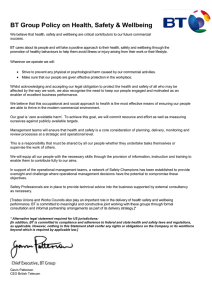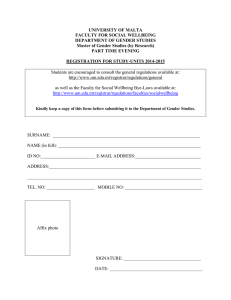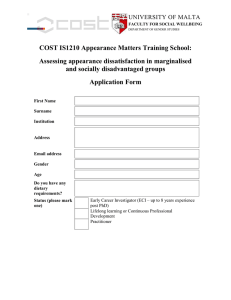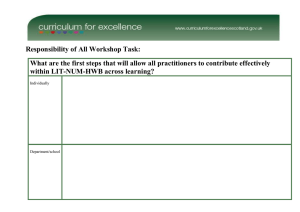Enable others to develop and apply their knowledge and skills in
advertisement
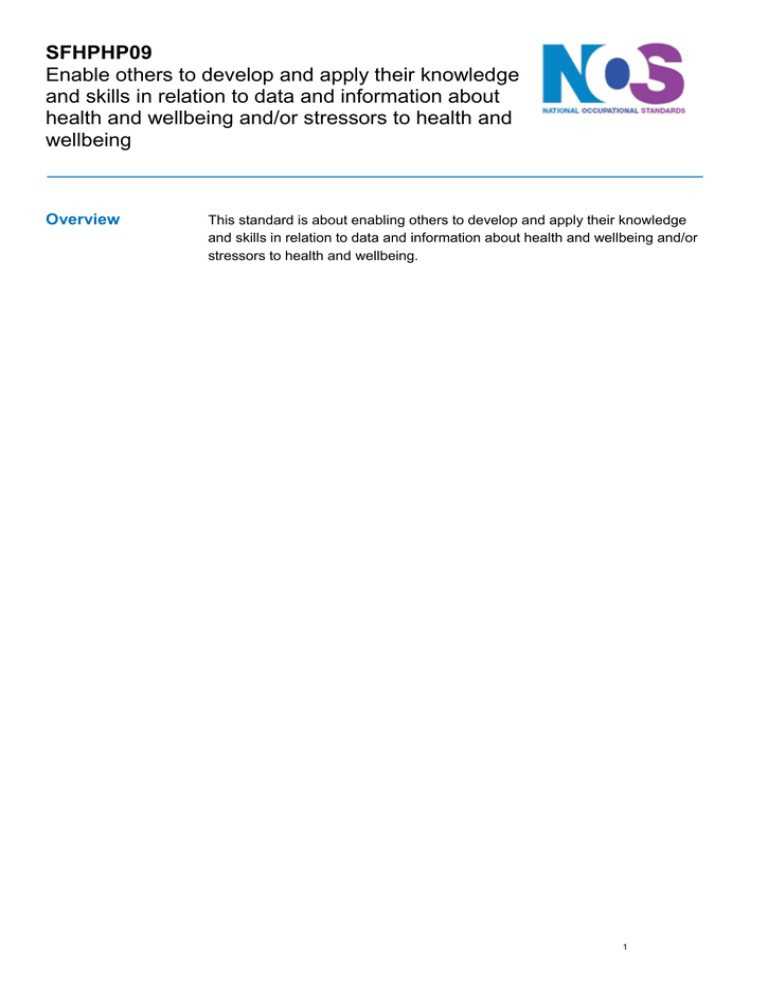
SFHPHP09 Enable others to develop and apply their knowledge and skills in relation to data and information about health and wellbeing and/or stressors to health and wellbeing Overview This standard is about enabling others to develop and apply their knowledge and skills in relation to data and information about health and wellbeing and/or stressors to health and wellbeing. 1 SFHPHP09 Enable others to develop and apply their knowledge and skills in relation to data and information about health and wellbeing and/or stressors to health and wellbeing Performance criteria You must be able to: P1 P2 P3 P4 P5 P6 P7 P8 prioritise the people who are most in need of support at different points in time explain in a manner appropriate to the people concerned: P2.1 the limits of data and information P2.2 how data and information can or cannot be validly and reliably collected, analysed, communicated and applied P2.3 the complexity of inter-relationships between different sources of data and information and the difficulty this can cause for its use P2.4 any tensions between the uses to which people wish to put data and information and the nature and applicability of that data and information offer further data and information that may be of relevance to people's needs in time for it to be of use encourage people to understand how their interaction with, and use of, data and information may not have the desired effects and any inherent risks recommend courses of action that highlight: P5.1 the benefits to be gained P5.2 any potential constraints demonstrate skills and good practice in data and information handling, management and use to people to facilitate their understanding and develop their own skills encourage people to seek advice on the worker's area of expertise when it would benefit them to do so provide support to people at relevant times as they develop their own knowledge 2 SFHPHP09 Enable others to develop and apply their knowledge and skills in relation to data and information about health and wellbeing and/or stressors to health and wellbeing Knowledge and understanding You need to know and understand: K1 K2 K3 K4 K5 the types of data and information: K1.1 community and population views of health and wellbeing needs and outcomes K1.2 routinely available data on reproduction, disability, illness, disease and death K1.3 data on the use of services (such as health and social care services) K1.4 data on measures to manage disability, illness and disease K1.5 data on the relationship between the physical environment and health and wellbeing K1.6 data on the relationship between the social environment and health and wellbeing K1.7 census data - key indicators and projections qualitative and quantitative data, how to use the two together and their respective limitations concepts of validity and reliability in relation to the design of data collection, collation and analysis the range of qualitative and quantitative data analysis methods available and the purpose of each how to interpret and present data and information including: K5.1 how to summarise and present information and the key issues emerging from it, in written, diagrammatic, graphic and pictorial, and audio form K5.2 comparing local populations with other populations identifying localities or groups with poor health and wellbeing using secondary data K5.3 comparing the health and wellbeing needs of different socioeconomic groups(using data on socio-economic status and health needs) K5.4 comparing health and wellbeing needs in different environments (e.g. the quality of air, water, food etc) using data on the physical environment and health K5.5 comparing health and wellbeing status and the assessment of health and wellbeing needs using data on health and biological determinants K5.6 comparing a locality with other populations through examining the scale of health and wellbeing problems in terms of incidence or prevalence 3 SFHPHP09 Enable others to develop and apply their knowledge and skills in relation to data and information about health and wellbeing and/or stressors to health and wellbeing K6 K7 K8 K9 K10 K11 K12 K13 K14 K15 K16 K5.7 assessing the importance of different risk factors in a given population, including socio-economic, lifestyle, ethnic and genetic factors ethical issues and legislative requirements surrounding data and information (e.g. small numbers and confidentiality) the profile of the local area with which the worker is concerned: K7.1 communities (neighbourhoods, communities of interest, communities of identity) K7.2 agencies and workers (across all sectors) K7.3 health and wellbeing: equalities and inequalities K7.4 illness: incidence, types, levels, problems and contributing factors, the likely extent of unreported illness and disability K7.5 structures and amenities K7.6 cultural diversity, community groups, formal and informal leaders, networks methods and approaches of community involvement the ways in which communication can be altered for different needs and contexts and how to respond to differences in the way that people communicate the specific legislation, guidelines of good practice, charters and service standards that relate to the work being undertaken and the impact of these on the work the services, policies and priorities of the worker's agency and how it relates to other agencies in the sector the data storage and retrieval systems used by agencies working in health improvement codes of practice and protocols about confidentiality and information sharing data and information about health and wellbeing and/or stressors to health and wellbeing between agencies working in partnership own role and responsibilities and from whom assistance and advice should be sought if necessary how to apply the principles of equality, diversity and anti-discriminatory practice to work how to develop one's own competence and skills in line with changes in knowledge and practice; how the worker's area and scope of practice are changing, the evidence which is available on the work and the implications of this for their own skill and knowledge base 4 SFHPHP09 Enable others to develop and apply their knowledge and skills in relation to data and information about health and wellbeing and/or stressors to health and wellbeing Additional Information External Links This standard links with the following dimension within the NHS Knowledge and Skills Framework (October 2004): Dimension: Core 2 Personal and People Development Level: 3 5 SFHPHP09 Enable others to develop and apply their knowledge and skills in relation to data and information about health and wellbeing and/or stressors to health and wellbeing Developed by Skills for Health Version number 1 Date approved June 2007 Indicative review date June 2009 Validity Current Status Original Originating organisation Skills for Health Original URN PHP09 Relevant occupations Health and Social Care; Healthcare and Related Personal Services Suite Public Health Key words Development, supporting others, enablement 6
